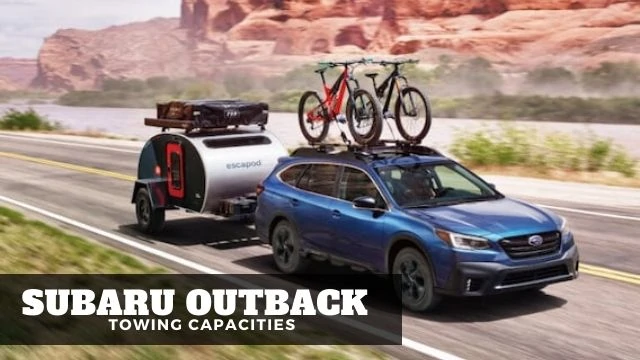The Subaru Outback has become an increasingly popular crossover vehicle and even today you see them everywhere on the road, but did you know did they actually have a decent towing capacity as well?
This caught me by surprise and I decided to do a little bit of research to see how much these little vehicles could pull and I was quite surprised by some of the results I found!
In this article, I lay out all the information I found in the owner's manuals that I grabbed directly from Subaru's website and compile the information in sort of a resource guide type of format. Let's get into it!
Overview of the Data For the Outback:
Engine Choices: There were a few different engine options over the course of the life of these vehicles, but to be honest, the engine you had equipped didn't make a huge difference when it came to capacity numbers, overall.
I do want to make it clear that there was a difference in the capacity numbers, depending on what engine you had equipped, but this only equated to 300-800 lbs. and not thousands of pounds like some other manufacturers, but it did make some impact.
- 2022, 2021, 2020, 2019, 2018, 2017, 2016, 2015, 2014, 2013, 2012, 2011, 2010, 2009, 2008, 2007, 2006 and 2005 Outbacks with a 2.5/2.5i: 1,000-2,700 lb. towing capacity.
2022-2010 Models:
- 2022, 2021 and 2020 Outbacks that had the 2.4L (4 cylinder) engine equipped had a 1,000-3,500 pound towing capacity.
- 2019, 2018 and 2017 Outbacks that used the 3.6R (V6) engine had a 1,000-2,700 lb. towing capacity.
- 2016, 2015, 2014, 2013, 2012, 2011 and 2010 Outbacks that used the 3.6R (V6) engine had a 1,000-3,000 lb. towing capacity.
2009-2000 Models:
- 2009, 2008, 2007, 2006 and 2005 Outbacks that had the 3.0L/3.0R (V6) engine equipped had a 1,000-3,000 pound towing capacity.
- 2004, 2003, 2002, 2001 and 2000 Outbacks that had the 2.5L engine equipped had a 1,000-2,000 lb. towing capacity.
- 2004 and 2003 Outbacks that used the 3.0L/H6-3.0 engine had a 1,000-2,400 lb. towing capacity and the 2002 and 2001 models had a 1,000-2,000 lb. capacity.
- 2000 Outbacks that had the 2.2L (4 cylinder) engine equipped had a 1,000-2,000 pound towing capacity.
Configurations: There were no real variations for this vehicle that equated to the fluctuations in the capacity ratings, like some manufacturer's vehicles. The charts basically had three different capacities listed: one weight specified for trailers with brakes, another for trailers without brakes, and yet another (reduced) weight specification for steep inclines and hot weather.
The Different Models: I did want to point out that certain trim levels had options when it came to many things, but engine options were another thing that depended on the trim level. Nearly every model year I have listed had a tow rating that was dependent on the engine that was installed in your vehicle.
You don't really need to know the trim level in order to get your maximum trailer weight rating, but if you are curious about the trim levels and what options came with each variation, then I suggest you take a look at the Subaru brochures.
Trailer Weight Rating: Over the years these vehicles have not really changed all that much when it came to their tow ratings overall, in fact most models ranged from 1,000-3,000 pounds. The earlier models (2004-2000) had slightly lower ratings than the other model years and the newest models had some of the highest ratings, going all the way up to 3,500 lbs.
Some model years share the same metrics in their charts so instead of posting the same chart for different model years, I grouped them together, but the information will be accurate for all model years listed in that section.
Be sure to read through the owner's manual yourself to get familiar with your particular vehicle and to keep yourself as up-to-date as possible on everything Subaru recommends when it comes to pulling a trailer or anything else.
2022, 2021 and 2020 Models:
The 2022-2020 models had two different engine choices to choose from, as you can see in the chart below and these were either a turbocharged 2.4 L engine or a 2.5 L engine.
The towing capacity for the 2022, 2021 and 2020 Subaru Outback ranged from 1,000-3,500 lbs. and really was dependent upon the engine you had equipped and whether the trailer you were pulling had its own braking system installed.
If we look at models that had the standard 2.5L Subaru Boxer engine equipped, in the chart below, we can see that it had a 2,700 lb. maximum trailer weight rating, as opposed to the 3,500 pound rating that the 2.4L engine was capable of pulling. This surprised me because the 2.5L engine is slightly bigger, but that seemed to make no difference in this case when we look at how much weight each option is able to pull.
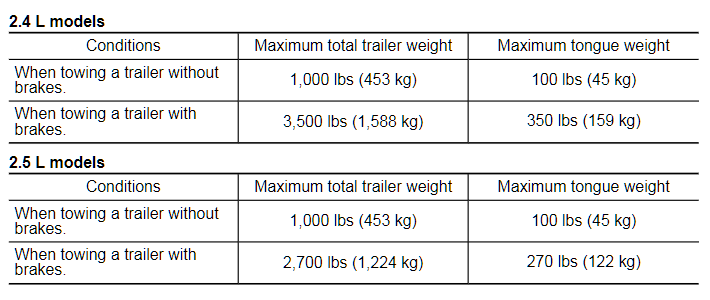
2021 & 2020 Charts
2019 & 2018 Models:
The towing capacity of the 2019 and 2018 Subaru Outback ranged between 1,000-2,700 lbs. and had an 800 pound deficit when it came to the total weight than we saw for the 2020 and 2021 models, mainly due to the new 2.4L engine that was used for the newer model years.
There were also different engine choices available for these model years, which were either a 3.6L engine or that same 2.5L engine. Both engines had identical metrics when we looked at the chart, and I'm very surprised by this because the 3.6 liter engine is much larger than its 2.5L counterpart that is also offered.
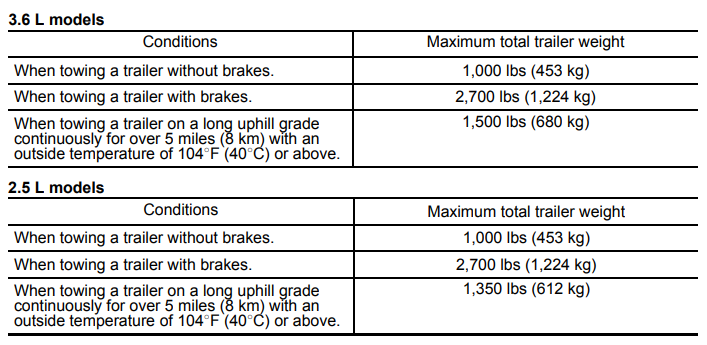
2019 and 2018 Charts
2017 Models:
The 2017 models had almost identical specs when we compared it to the 2019 and 2018 models, but if we look at the chart we can see that it is a little bit different, mainly when it comes to the models equipped to the 2.5l 4-cylinder (Subaru Boxer) engine. The overall towing capacity for the 2017 Outbacks ranged from 1,000-2,700 lbs. and was still relatively unchanged when we compare their towing capability to older models.
The 2.5 L engine option came in either a manual transmission or a continuous variable transmission, which is basically just an all-wheel drive version and this is how the chart was split up, even though both manual transmission models CVT models still had the same exact specs when we compare the two.
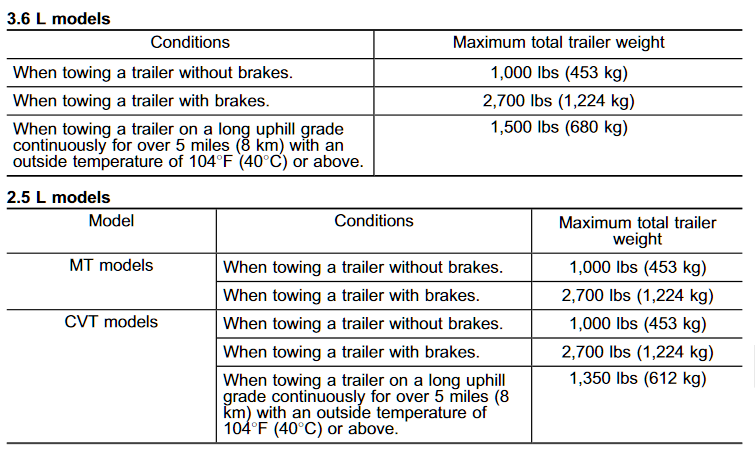
2017 Chart
2016-2010 Models:
The 2016-2010 models all had the same chart associated with them because they used the same engine lineup, so I posted one chart that applies to all of these model years. The towing capacity for the 2016, 2015, 2014, 2013, 2012, 2011 and 2010 Outbacks ranged from 1,000-3,000 lbs.
I did post two separate charts below and the top chart is for the 2016-2013 models, while the chart below that is for the 2012-2010 models, but essentially, all of the information is the same if you compare the two charts. It was just laid out differently when it came to the lower portions of the charts.

2016, 2015, 2014 and 2013 Charts
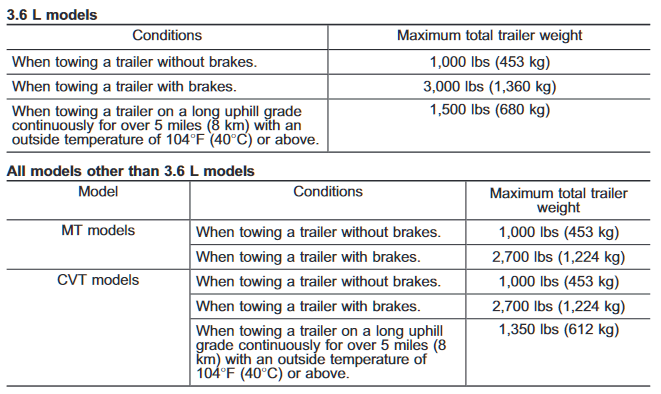
2012, 2011 and 2010 Charts
2009-2005 Models:
The 2009-2005 models had a different layout, as far as the chart was concerned, but the engine lineup was essentially the same, with the 3.0 L engine being at the top, and other models equipped with a different engine below that. The other models used the 2.5-liter boxer engine, which was a 4-cylinder engine, compared to the 6 cylinder 3.0L engine.
The towing capacity for the 2009, 2008, 2007, 2006 and 2005 Subaru Outbacks, ranged from 1,000-3,000 lbs. and was the same overall range as the newer (2016-2010) models had.
The lower portion of the chart shows manual transmission models, along with automatic transmission models, but both what types of transmissions have essentially the same maximum trailer weight specifications rated except for the automatic transmission models which have a conditional weight limit attached to it.
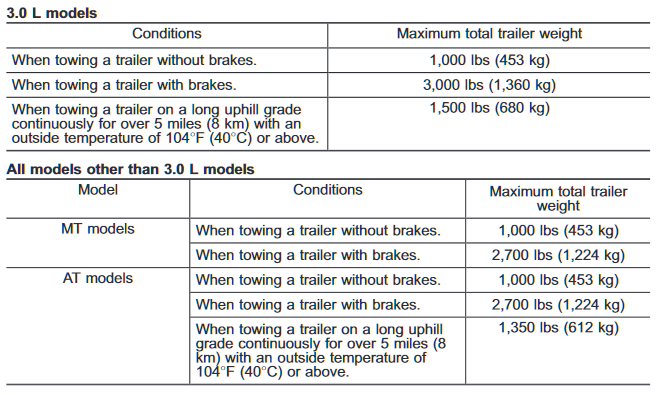
2009, 2008, 2007, 2006 and 2005 Charts
2004 & 2003 Models:
The 2004 and 2003 models had a completely different chart than what we saw before and these were divided up into manual transmission and automatic transmission models, along with the "wagon" chart, showing above and then all other models below that chart, as separate specifications.
We can also see that the towing capacity for the 2003 and 2004 Outback ranged from 1,000-2,400 lbs. and was slightly less than newer models, which had an additional weight rating of about 700-1,000 pounds.
The Wagon models had most of the power for the 2004 and 2003 models compared to the other options available at that time, and a 400 lb maximum load difference is pretty significant when you consider the overall maximum tow ratings that were specified ad equates to a 20% advantage!
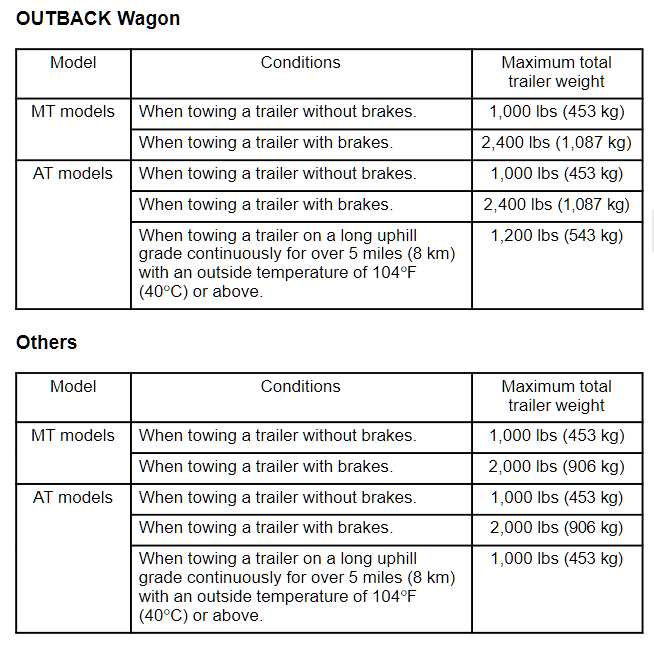
2004 & 2003 Charts
2002-2000 Models:
The 2002, 2001 and 2000 Subaru Outbacks had a towing capacity that ranged from 1,000-2,000 lbs. and were the lowest ratings there were, out of all of the model years listed in this article. With a much more simplified chart, there were only manual and automatic transmission models listed and a pretty "cut and dry" maximum tow capacity rating for braked and unbraked trailers.
There were also no models listed on the chart or engine specifications, which makes the chart easy to read and understand.
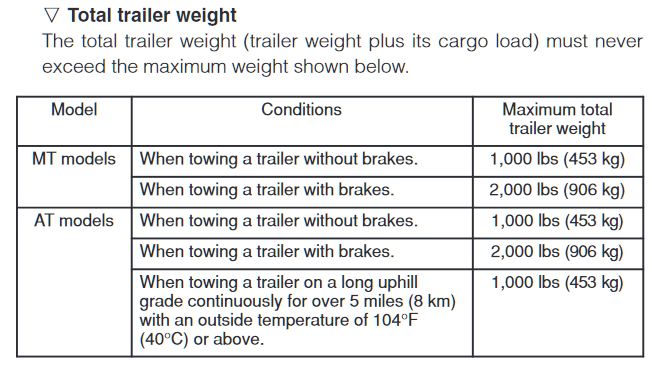
2002, 2001 and 2000 Charts
What Engine Do I Have?
I think that most people can figure out what engine they have equipped in their vehicle, which was the most important metric that affected the weight ratings, but I'm sure that some of us out there may be confused when opening up the hood to look at the engine.
If you are having trouble finding the type of engine that came equipped with your vehicle from the factory, then I would recommend you locate your VIN and plug it into an online decoder. This will tell you what engine you have, so you can then get an accurate maximum trailer weight rating.
Different Transmission Options
For most of the model years (2000-2017) there were transmission specifications listed and they weren't always clear when it came to what type of transmission they were talking about. In most cases, you can figure out certain abbreviations like MT and AT which stood for automatic transmission and then manual transmission, but there was another abbreviation that was not as clear.
The other option that was listed was a CVT option, which stands for continuously variable transmission and this was an automatic transmission. This was an important part of the puzzle, as it affected the weight ratings quite substantially, especially when it came to driving up long uphill grades in hot weather.
Long Uphill Grades & Hot Weather
If we look at the information in the charts for most of these vehicles, we can see that there is a section that lists different weight ratings for two specific road conditions. These two road conditions are an uphill grade that is 5+ miles in length with the additional element of hot weather, which in this case is specified as 104 degrees F and hotter.
The weight ratings for these "conditions" are reduced to 50% of the maximum trailer weight specification, which is huge! This is because uphill grades, especially longer ones and hot outside temperature make the engine and transmission work a lot harder than it usually has to and heats up these two components mush faster, which is usually what leads to damage. This is compounded by the fact that you are now pulling additional weight with your loaded trailer and all three of these factors can be a potential for disaster.
That's why the weight limits are significantly reduced to prevent overheating and overworking the engine and transmission. Turning off your AC and keeping your RPMs around the 2K mark are also two other things you can do to make life easier on your vehicle when you encounter more extreme road conditions.
What Kind of Trailers Can I Pull?
You didn't have a huge weight limit when it came to the types of trailers you can pull with these vehicles, because you only had a range of 1,000-3,500 pounds, but there are still a few choices out there.
The weight of the trailer will have to be considered, especially if you are planning on hauling something in it because the lighter the trailer is, the more capacity you will have overall. Depending on your specific model year, some of your best options are lighter weight trailers like:
- Small Campers: In recent years, campers have really changed and more lightweight camper options have become available that are perfect for vehicles that have a lower trailer weight rating, like these vehicles. Some examples of smaller campers include the Winnebago Hike 100, the MyPod camper and the Little Guy Mini Max to name a few.
- Teardrop Trailers: Teardrop trailers are another type of smaller camp trailer with a more rounded shape to them and most average teardrop trailers are pretty lightweight. As an example, most of the teardrop trailers offered by ColoradoTeardrops.com would be a good match.
- Motorcycle Trailers: Motorcycle trailers usually only weigh a few hundred pounds and if you are hauling a motorcycle with the trailer, this will usually only equate to an additional few hundred pounds, making these a definite possibility!
- Any Type of Small Trailer: There are lots of other small trailers out there that will fit into this "lightweight" trailer category and can include smaller utility trailers, jet ski trailers, kayak trailers, etc.
- Bike Carriers: A bicycle carrier is also a possibility and even lighter than trailers because they are essentially an attachment that usually weighs a couple of hundred pounds, at the most.
Remember that your weight limit is tied to tour lowest rated piece of equipment, so you need to make sure that your accessories (tow hitch, trailer hitch, ball mount, etc) are rated to handle the amount of weight your vehicle can pull or exceed those specifications.
GVWR, GCWR and GAWR Specs...
I was not able to find the gross combined weight rating metrics anywhere online or in the owner's manuals, but I was able to find the gross vehicle weight rating and gross axle weight ratings, or where you can find the information, at least.
The gross vehicle weight rating and gross axle weight ratings were not listed in any of the owner's manuals, but the manuals did specify where I can find this information.
The certification label can be found if you open the driver's side door of your vehicle and look for a sticker on the door jamb or in that area. This label will contain a lot of useful information including the gross vehicle weight rating and gross axle weight ratings.
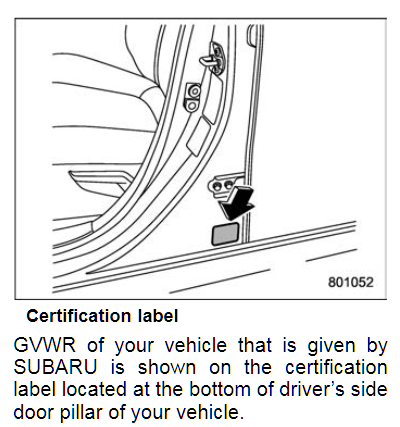
Subaru Certification Label
A Note On Trailer Brakes...
Trailer brakes were required for trailers that weighed 1,000 pounds or more and that was for every model year and was stated in every chart I have posted in this article. In fact, the lower maximum trailer weight ratings were set at 1,000 pounds for trailers that did not have a braking system equipped.
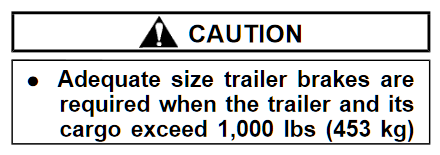
The trailer brakes also played an important role when it came to the trailer weight ratings that were specified in the charts. There were separate specs listed for trailers that had brakes and trailers that did not have brakes, which is also referred to as "braked" and "unbraked" ratings.
The weight difference between these tow ratings was huge! For some of the earlier model years, the difference could vary by 1,000-1,700 pounds between the two different weight ratings and for some of the newer models that amount was increased to a 2,500 pound difference!
Resources For This Article:
All of the information in this article came from the owner's manuals that I grabbed directly from Subaru's website because I wanted the information to be as accurate as possible and I usually link to the individual manuals but in this case each manual was for a specific model, so I chose not to link to any of the manuals.
I did check out the different manuals and compared the specifications and discovered that the trailer weight rating specs were shared for each model year so it didn't matter what manual you looked at, as the trailer's maximum weight rating metrics were identical.
I also wanted to point out that the individual brochures that were available for these vehicles came in extremely helpful as well and laid out all of the available options that were available for these vehicles. It compared the different trim levels and listed the different options that were available for each trim level, which was a huge help when it came to organizing the data. They are worth checking out and you can find most of them here.
Last updated on May 29th, 2022 at 09:21 am
